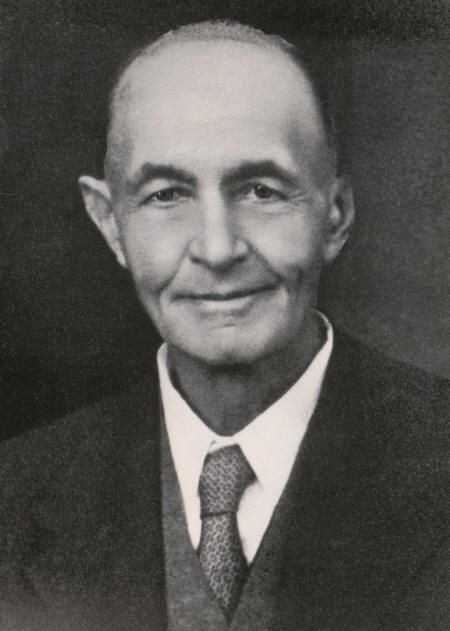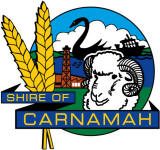Roads to Government
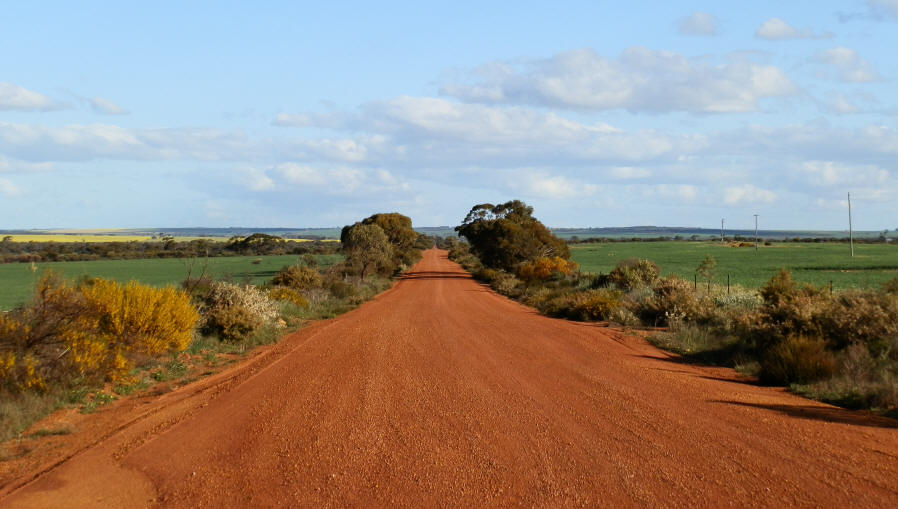

From 1901 the development and maintenance of roads in Mingenew, Three Springs, Carnamah and Coorow was administered by the Upper Irwin Road Board in Mingenew. The board was initially made up of several Mingenew men who met once a month to decide how they should spend the rates paid by landowners. The primary concern of the board was the main Perth-Geraldton Road and the crossing over the top of the Yarra Yarra Lakes. People establishing farms out in the bush would request and petition for new roads to be surveyed so they could be connected to the outside world. Carnamah had no representation until 1910 when Donald Macpherson was elected to the board.
“Mr P. O’Halloran of Mingenew has been viewing the Carnamah country with Donald Macpherson, and as Mr O’Halloran is chairman of the Upper Irwin Road Board it’s safe to say that Mac drove into every hole and boulder about the district, and that a fair sum of money will be allotted to Carnamah roads when Chairman Pat gets his Road Board members together again.” -- The Moora Herald newspaper
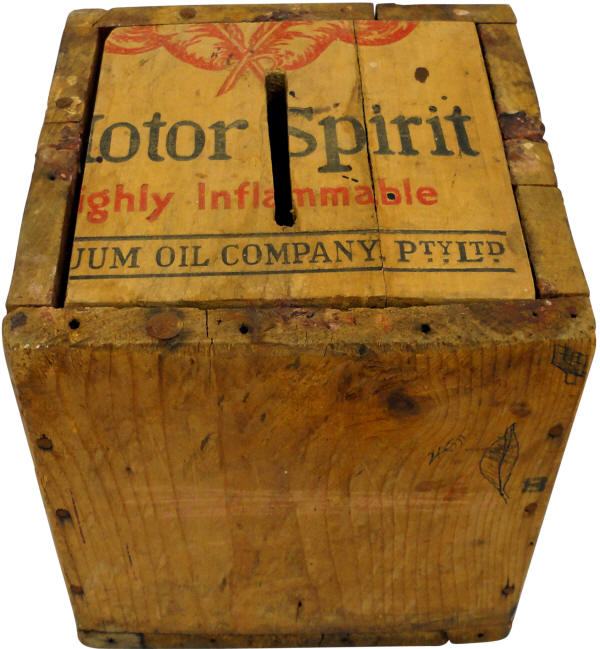
Ballot Box used in Carnamah
for Road Board elections
People interested in representing their community could nominate to serve on the Road Board and elections were then held to decide the successful candidate.
As Carnamah's population increased the community had more votes and was able to elect more local members to the Road Board at Mingenew. Carnamah farmers Donald Macpherson, Arthur Darling and John Bowman were all serving on the board by 1921.
for Road Board elections
People interested in representing their community could nominate to serve on the Road Board and elections were then held to decide the successful candidate.
As Carnamah's population increased the community had more votes and was able to elect more local members to the Road Board at Mingenew. Carnamah farmers Donald Macpherson, Arthur Darling and John Bowman were all serving on the board by 1921.
Right: Carnamah farmer John Bowman
"He became an ardent fighter for the establishment of a road board at Carnamah, and there would not be a Road Board at Carnamah now if it had not been for John Bowman."
-- James K. Forrester
The Carnamah District Road Board was gazetted on 24 August 1923 and roughly encompassed the present-day districts of Coorow, Carnamah and Three Springs.
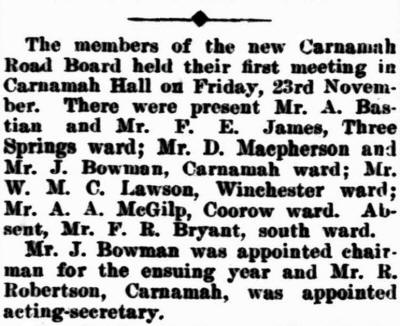
"He became an ardent fighter for the establishment of a road board at Carnamah, and there would not be a Road Board at Carnamah now if it had not been for John Bowman."
-- James K. Forrester
The Carnamah District Road Board was gazetted on 24 August 1923 and roughly encompassed the present-day districts of Coorow, Carnamah and Three Springs.

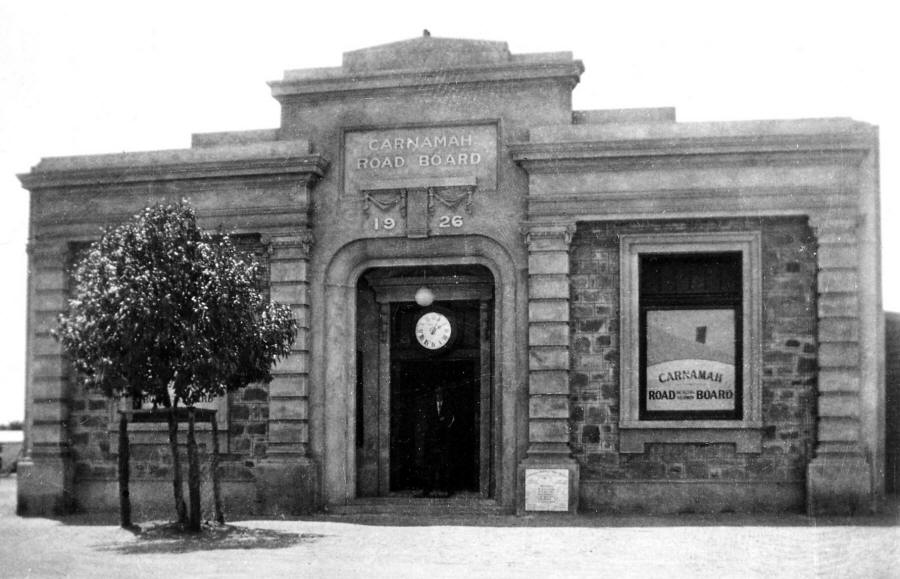
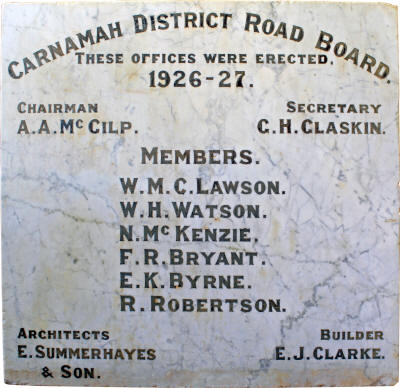
Above: Road Board Offices
The Carnamah District Road Board's first office was a room rented from the Midland Railway Company at the Carnamah Railway Station.
In 1926 stone offices, shown above, were built onto the front of the Carnamah Hall. These were used until 1962 when they were demolished to make way for a new and larger hall.
Left: Plaque from Road Board Offices
The Carnamah District Road Board's first office was a room rented from the Midland Railway Company at the Carnamah Railway Station.
In 1926 stone offices, shown above, were built onto the front of the Carnamah Hall. These were used until 1962 when they were demolished to make way for a new and larger hall.
Left: Plaque from Road Board Offices
Right: Mrs Kate McIntosh's
Sulky Number-plate
Local vehicles, which included those pulled by horses, had to be licensed with the Road Board and then received number-plates containing CA for Carnamah.
Sulky Number-plate
Local vehicles, which included those pulled by horses, had to be licensed with the Road Board and then received number-plates containing CA for Carnamah.
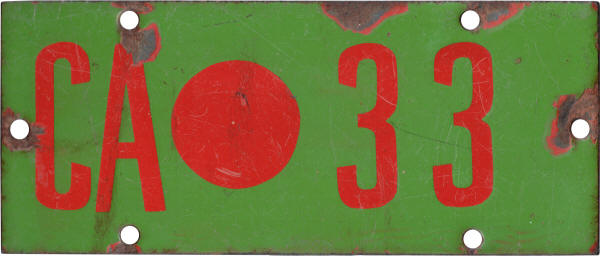
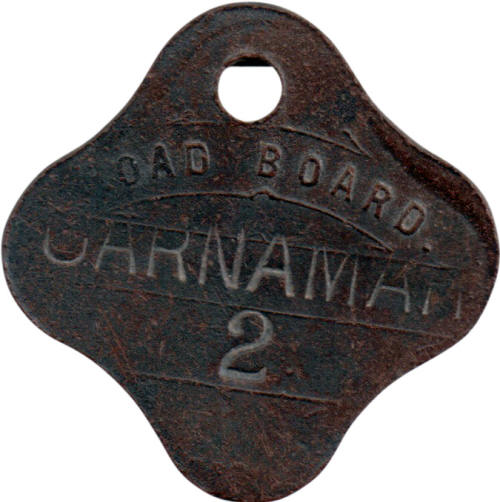
Left: Carnamah
Dog Tag
In addition to roads, the board was also responsible for controlling vermin. For a number of years the board paid a "Vermin Bonus" for anyone who killed a fox, dingo or eagle. Rabbits were controlled by the compulsory laying of poison baits once a year. Baits were also laid to kill grasshoppers in the great plague of 1937.
It was a requirement that pet and farm dogs be registered and wear a tag so they could be distinguished from strays and dingoes. The dog tag to the left, which is about two centimetres wide, was found in the dirt on a Carnamah farm in the mid 1990s.
In addition to roads, the board was also responsible for controlling vermin. For a number of years the board paid a "Vermin Bonus" for anyone who killed a fox, dingo or eagle. Rabbits were controlled by the compulsory laying of poison baits once a year. Baits were also laid to kill grasshoppers in the great plague of 1937.
It was a requirement that pet and farm dogs be registered and wear a tag so they could be distinguished from strays and dingoes. The dog tag to the left, which is about two centimetres wide, was found in the dirt on a Carnamah farm in the mid 1990s.
Gilbert H. Glaskin was the second secretary of the Road Board. His
employment came to an abrupt and dramatic end in June 1927 when an
auditor discovered he had stolen over £400. He was immediately
dismissed and a warrant was issued for his arrest.
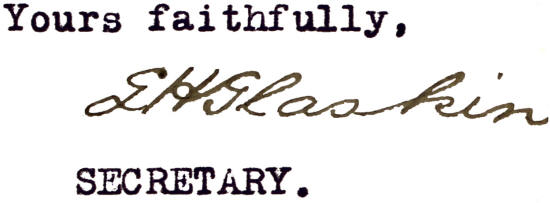
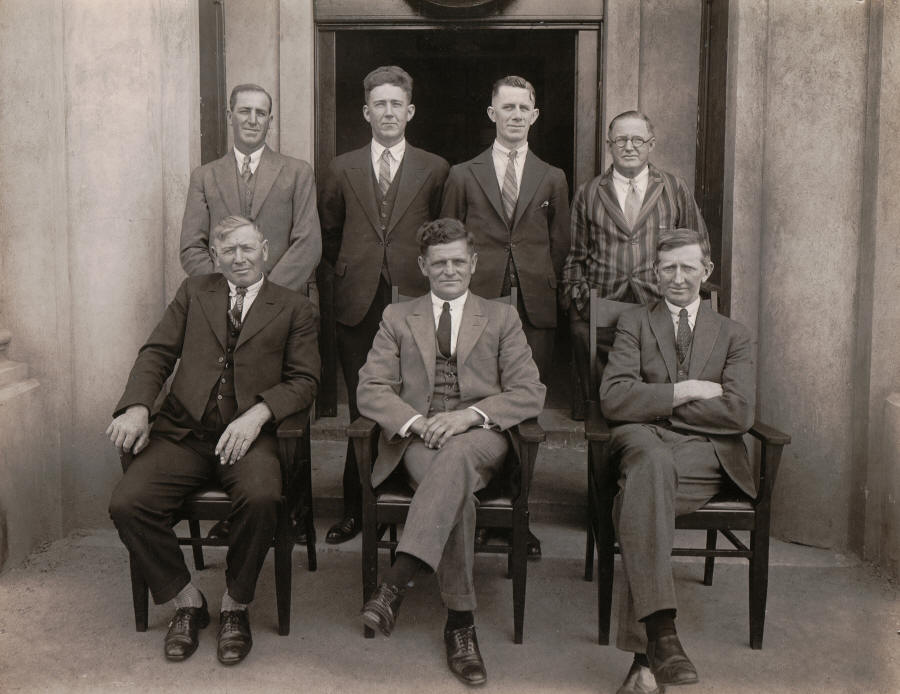
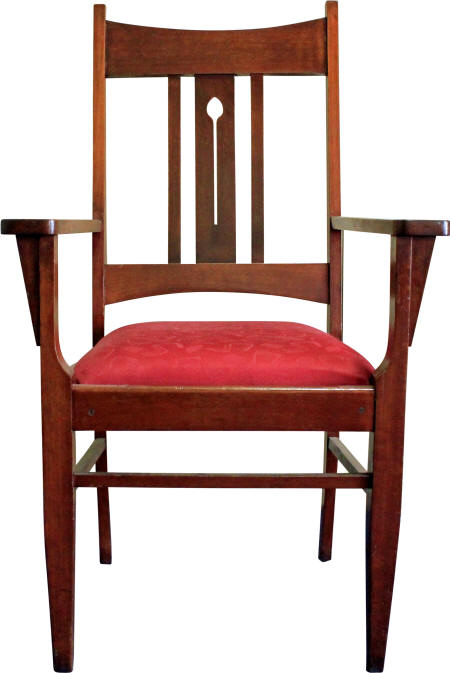
Above: Carnamah District Road Board in 1933
Following the formation of the Three Springs Road Board in 1928 the Carnamah District Road Board shrank in size.
Standing in the above photo from left to right are Tom White of Winchester, Bob Wells of Coorow, Arnold Bierman (secretary) and Andrew Smart of Carnamah. Seated are Frank Bryant of Marchagee, JK Forrester of Carnamah (chairman) and Angus McGilp of Waddy Forest.
Left: Board Room Chair (also in the above photo)
"I was the chairman. Arnold Bierman was the secretary. We were a happy family and we looked forward to the monthly meetings. McGilp from Coorow was the Deputy Chairman. He was down to earth – very common sense. He had a big property at Coorow. At one stage we were the lowest rated Road Board in WA. We did get some money by getting contracts from Main Roads Department. Tom Paterson was the young Foreman. We did the road to Sivyer’s corner. This earned £1,000 and it enabled us to buy a grader. A contract at Winchester also gave us about £1,000. This enabled us to buy a truck." -- James K. Forrester
Following the formation of the Three Springs Road Board in 1928 the Carnamah District Road Board shrank in size.
Standing in the above photo from left to right are Tom White of Winchester, Bob Wells of Coorow, Arnold Bierman (secretary) and Andrew Smart of Carnamah. Seated are Frank Bryant of Marchagee, JK Forrester of Carnamah (chairman) and Angus McGilp of Waddy Forest.
Left: Board Room Chair (also in the above photo)
"I was the chairman. Arnold Bierman was the secretary. We were a happy family and we looked forward to the monthly meetings. McGilp from Coorow was the Deputy Chairman. He was down to earth – very common sense. He had a big property at Coorow. At one stage we were the lowest rated Road Board in WA. We did get some money by getting contracts from Main Roads Department. Tom Paterson was the young Foreman. We did the road to Sivyer’s corner. This earned £1,000 and it enabled us to buy a grader. A contract at Winchester also gave us about £1,000. This enabled us to buy a truck." -- James K. Forrester
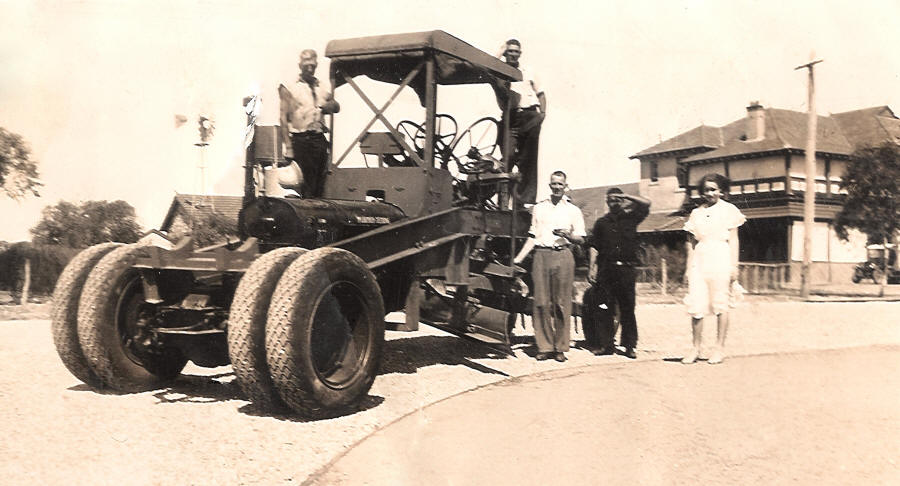
During the early years of the Road Board the clearing and forming of roads was outsourced to contractors, who were often local farmers. Prior to the availability of road-making machinery all of the work was done with axes and shovels. Once the Road Board was more established, it employed two road gangs which worked in Carnamah and Coorow. The arrival of the first grader revolutionised productivity.
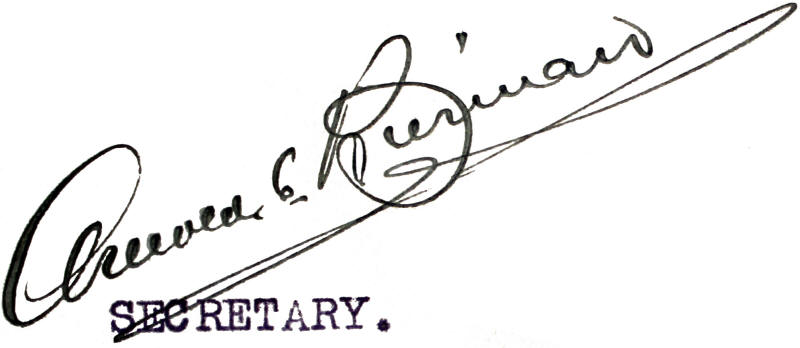
Arnold C. Bierman was secretary of the Road Board for 30 years, from 1927 until
1957. With assistance from his wife he undertook all of the Road Board's
administration, correspondence, minutes and accounts.
Right: Inkwell and Nib Pen
This glass inkwell was used by Arnold at the Road Board's offices. Small jars of ink sat in the compartments of the inkwell and when anything needed to be written the nib pen was dipped into one of the jars to wet its blade with ink.
This glass inkwell was used by Arnold at the Road Board's offices. Small jars of ink sat in the compartments of the inkwell and when anything needed to be written the nib pen was dipped into one of the jars to wet its blade with ink.
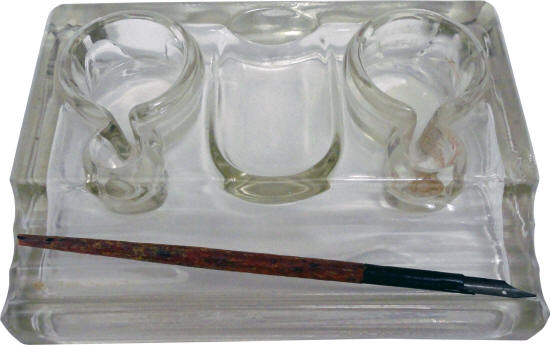
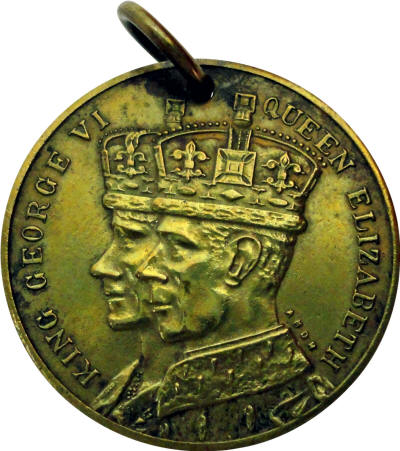
Right: Coronation Medal
The Road Board helped provide health services, assisted local organisations with sport and recreational facilities, and looked after community halls. The board employed a sanitary and rubbish collector for the Carnamah townsite from 1927 and during the same year opened the Winchester Cemetery. The board had a hall built at East Marchagee in 1933 and in 1938 opened a freshwater swimming pool at Gunyidi.
In 1937 the Road Board purchased 500 coronation medals to present to children throughout the Road Board district. The medals were to celebrate the coronation of George VI as King of the United Kingdom and the British Commonwealth.
The Road Board helped provide health services, assisted local organisations with sport and recreational facilities, and looked after community halls. The board employed a sanitary and rubbish collector for the Carnamah townsite from 1927 and during the same year opened the Winchester Cemetery. The board had a hall built at East Marchagee in 1933 and in 1938 opened a freshwater swimming pool at Gunyidi.
In 1937 the Road Board purchased 500 coronation medals to present to children throughout the Road Board district. The medals were to celebrate the coronation of George VI as King of the United Kingdom and the British Commonwealth.
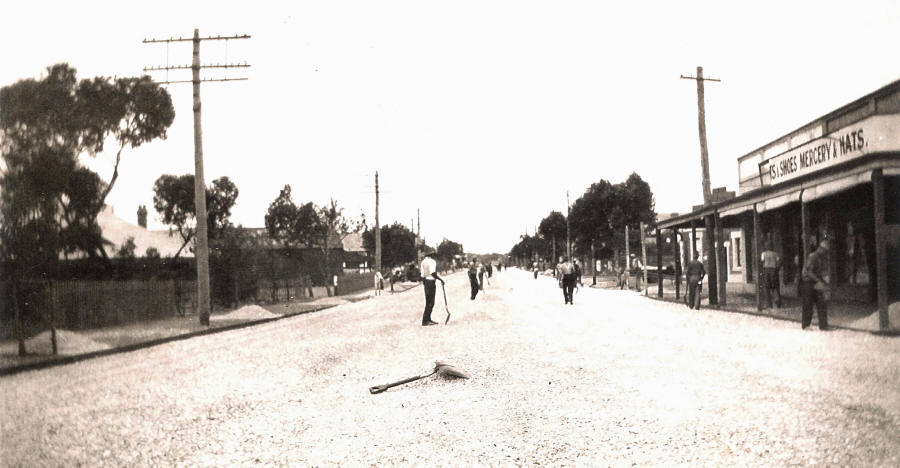
Above: Bitumenising of Macpherson Street, Carnamah in 1937
All roads and streets throughout the district were either dirt or gravel. After three years of consideration Macpherson Street was the first to be bitumenised in 1937. Other streets and major roads were slowly bitumenised over many years. With the establishment of farms at Eneabba in the 1950s the Road Board had a whole new network of roads that needed to be cleared and developed.
Below: Proposed Plans for New Recreation Reserve in Carnamah in 1958
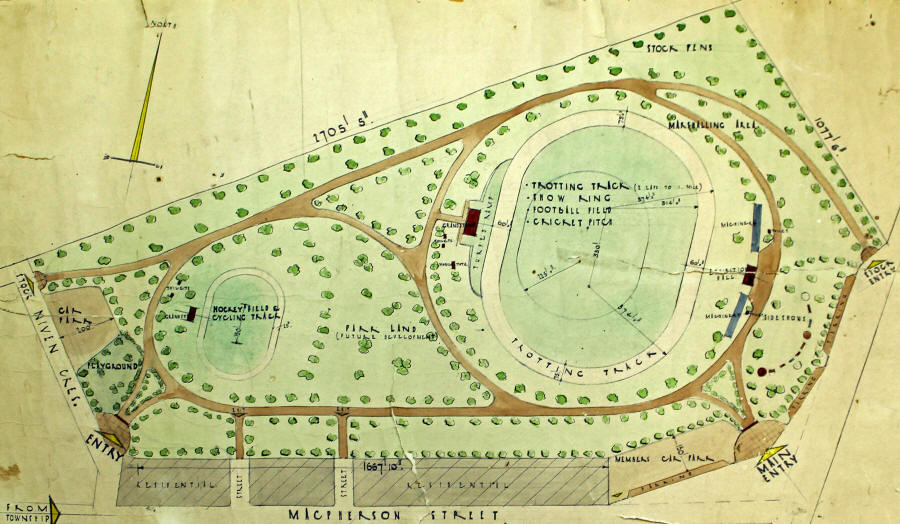
Road Board to Shire
In 1961 the WA Government made changes to state legislation that resulted in the Carnamah District Road Board becoming the Carnamah Shire Council. There were then councillors rather than board members, and a president instead of a chairman. The secretary became known as the shire clerk and later still as the chief executive officer.
In 1962 the shire was split in two with the southern half breaking away to become the Shire of Coorow. Both shires extend to the coast of the Indian Ocean.
Below: Collecting the Keys for the Shire's three new Ford Trucks in 1966
In 1961 the WA Government made changes to state legislation that resulted in the Carnamah District Road Board becoming the Carnamah Shire Council. There were then councillors rather than board members, and a president instead of a chairman. The secretary became known as the shire clerk and later still as the chief executive officer.
In 1962 the shire was split in two with the southern half breaking away to become the Shire of Coorow. Both shires extend to the coast of the Indian Ocean.
Below: Collecting the Keys for the Shire's three new Ford Trucks in 1966
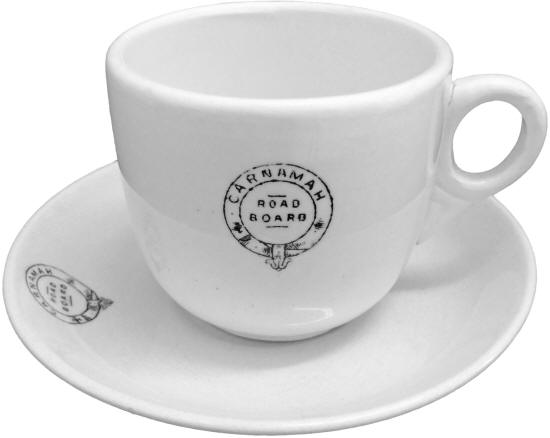
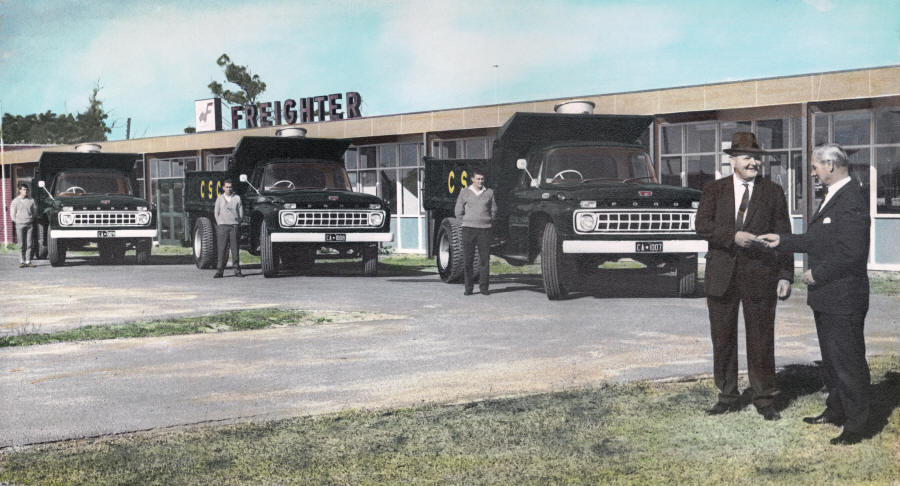
Positive Change of Time
In 1981 Lila Flegg took the bold step of nominating for council despite no woman having ever done so in the past. She was unsuccessful but had set the wheels of change in motion. The following year, in 1982, Ruth White nominated and was elected. Ruth was the first female councillor and went on to became the first female president in 1988.
Right: Road Board Clock
This large clock was donated by car salesman Robert Mackie in 1927 and hung in a brass case above the front door of the original Road Board offices. Following restoration the clock was hung inside the Shire of Carnamah's new chambers, pictured below.
In 1981 Lila Flegg took the bold step of nominating for council despite no woman having ever done so in the past. She was unsuccessful but had set the wheels of change in motion. The following year, in 1982, Ruth White nominated and was elected. Ruth was the first female councillor and went on to became the first female president in 1988.
Right: Road Board Clock
This large clock was donated by car salesman Robert Mackie in 1927 and hung in a brass case above the front door of the original Road Board offices. Following restoration the clock was hung inside the Shire of Carnamah's new chambers, pictured below.
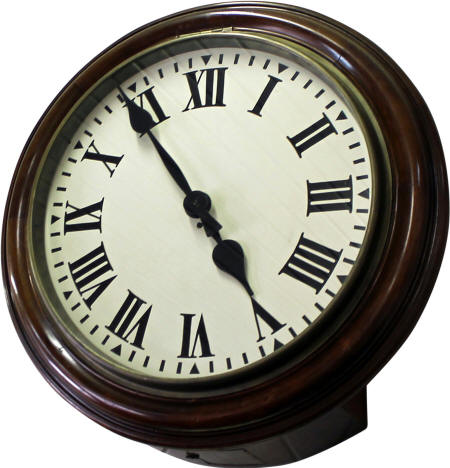
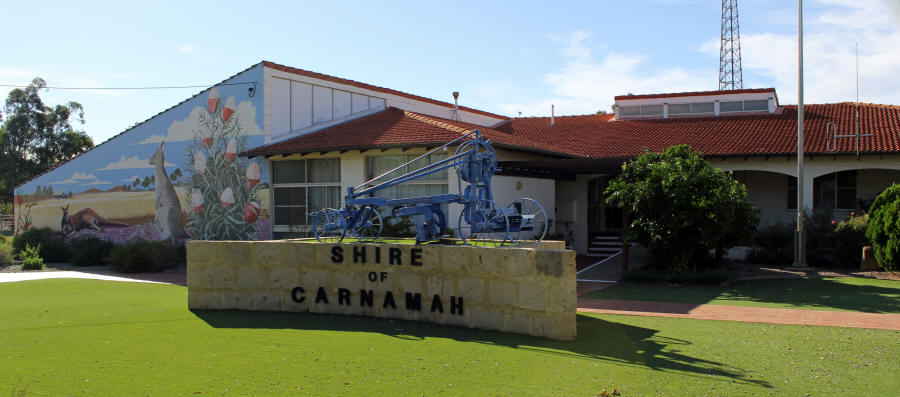
Local government has grown and evolved to care for a lot more than roads. In its present strategic plan the Shire of Carnamah aims to foster the environment and economy while delivering on local infrastructure, health services, educational facilities, town beautification, tourism, aged services, sports, recreation, culture and the arts. Number-plates on local vehicles still contain CA for Carnamah.
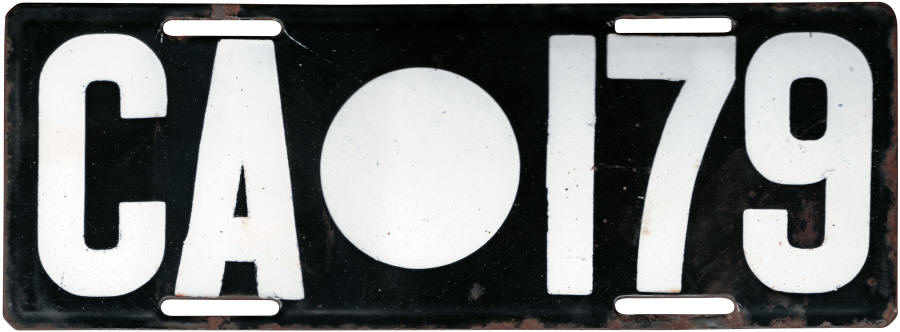
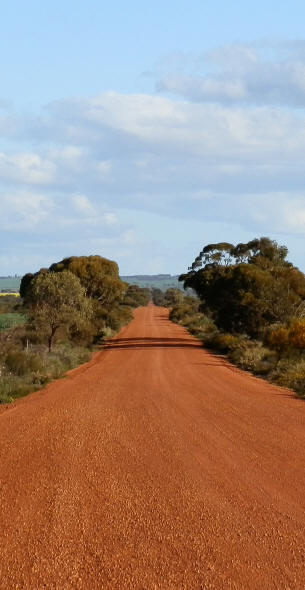
Helen Green (nee Rowland)
Mr Paterson was the grader driver and he used to grade our road. We had a cubby house between the road and our farm’s fence. The fence of our cubby always went halfway out onto the road and back but he never ever knocked our fence down – he always went around our fence for us. He also used to dig drains from the road into our paddock. Graeme my brother and I used to go along and shovel them and put them back onto the road. We didn’t want the water running through our place. Kids wouldn’t even be interested in doing stuff like that now.
Peter Thomson
In 1946 the Carnamah Road Board consisted of members who had been serving for many years. As is often the case, they were criticised for being a close-knit club and a law unto themselves. I was therefore breaking ranks when I nominated for the South Ward against Mr Bryant. However, we did our homework and by in particular chasing absentee ratepayers, I had a comfortable victory.
Some of the Board members did not accept the change graciously but the Chairman was Mr J K Forrester and he gave me encouragement for which I was most grateful. The Secretary was the very efficient Arnold Bierman who was accused of running the Board. Initially his, was a most professional approach, but by the time I became Chairman of the Board, I could appreciate his value not just as an officer of the Board but as a member of a good administrative team.
At the stage I just became a Board member, there was very little sophisticated machinery used and two early contracts which were carried out in the South Ward were for gravelling one section of road and clearing another road reserve preparatory to forming up. The gravel was loaded on to the truck by shovels and distributed from the truck in the same method. The clearing was similarly a manual task by axe and mattock. Subsequently the Coorow and South wards combined their loan raising resources to purchase a grader and progressed onto acquire a balanced road making plant over the next few years.
Cyril Rayner
The Road Board office was at the front of the hall. Mr & Mrs Bierman just had one office. Mrs Bierman was there all the time. They ran it between them. It is hard to imagine how they managed when you look at the size of the Shire staff now! In Bierman’s time there were about four or five times as many people in town and five or six times as many on the farms. The main Road Board workers were the grader operator and the truck driver. They had one or two odd blokes. Coorow was part of Carnamah Road Board and there was no settlement on the other side of the lakes.
Ray Boyer
I worked on the Carnamah Road Board for 38 years. I retired in 1990. I started on the Road Board in 1953 and we moved into Carnamah in 1954. When I started I used to go down to Coorow. I used to drive the dozer down there.
I used to drive around Coorow with the dozer. I had an FJ Holden car and a little caravan. The caravan belonged to the Shire. I was camped on the Gunyidi road near Vanzetti's and Randall's. I had to clear this gravel pit. You’ve never seen a bee fly so straight in all your life. Here’s me sitting up in this dozer with an Armstrong ripper behind and this bee came in a straight line. Bang! He got me and I knew that he got me. I shut the dozer down and I made one beeline straight to the caravan. I was there two days - I could’t move, I couldn't see a thing. I knew that Mick Rodan wasn't coming anywhere near me; no one came along the road or anything. When I came home I was still puffed up.
The coast road was put in by two logs that we got out at Clayton’s on the Three Springs-Perenjori Road. Fitzgerald, the mechanic at Dallimore's, turned around and drilled them and plugged them with steel. It was pulled along behind David Heinrich’s dozer. Two logs went along and made a track through the bush from about Nigel Armstrong’s through to the S-bend. That’s how that got put through. Then we went in with graders. I always remember Roger Clark saying: “I want bitumen out here.” This was from 1953 to 1973. Twenty years later we got to his front gate!
I've worked on every road in the Shire. Bill Nelson and I had a lot to do with all the roads around Carnamah. So did other fellows like Lou Horner and Bert Hill and old Tom Paterson. There is not a road that I haven’t been over in this town that couldn't tell me a story back.
At Eneabba, Bill Nelson and I built the streets. We - Bill Nelson, Bert Martin and I - built the streets in Leeman. When the mineral crowds put the houses down at the south end we went in and put the roads in.
Young Merv Atkinson and I were down at Winchester Cemetery digging this hole. He was down the bottom and then suddenly he was on top. “What’s wrong?” I asked. "There’s a coffin in there!” I go down and there were boards everywhere!
Betty Brennan (nee Mulligan)
I remember Macpherson Street being bituminised as I didn't have a mudguard on my bike and I got tar all over my skirt on the way to school. The mothers got together and they said eucalyptus will do the trick Mrs Mulligan. You had to have numberplates on bicycles back then, registered with the Road Board. I had CA-1933 on mine as that's what Dad had on his ute.
Carnamah Historical Society & Museum
Please help enrich our collective history by sharing your own comment, story or memories about the Carnamah District Road Board or the Shire of Carnamah. Click here to go to the comment form or send us an e-mail to mail@carnamah.com.au
For photographs and information on the nine chairmen of the road board between 1923 and 1962, please see our page Chairmen of the Carnamah District Road Board.
Check out our Early WA Motor Vehicle Registrations index for the names of early vehicle owners, their address, type of vehicle, number plate and years registered. The index covers all of Western Australia and contains 80,153 entries!
Mr Paterson was the grader driver and he used to grade our road. We had a cubby house between the road and our farm’s fence. The fence of our cubby always went halfway out onto the road and back but he never ever knocked our fence down – he always went around our fence for us. He also used to dig drains from the road into our paddock. Graeme my brother and I used to go along and shovel them and put them back onto the road. We didn’t want the water running through our place. Kids wouldn’t even be interested in doing stuff like that now.
Peter Thomson
In 1946 the Carnamah Road Board consisted of members who had been serving for many years. As is often the case, they were criticised for being a close-knit club and a law unto themselves. I was therefore breaking ranks when I nominated for the South Ward against Mr Bryant. However, we did our homework and by in particular chasing absentee ratepayers, I had a comfortable victory.
Some of the Board members did not accept the change graciously but the Chairman was Mr J K Forrester and he gave me encouragement for which I was most grateful. The Secretary was the very efficient Arnold Bierman who was accused of running the Board. Initially his, was a most professional approach, but by the time I became Chairman of the Board, I could appreciate his value not just as an officer of the Board but as a member of a good administrative team.
At the stage I just became a Board member, there was very little sophisticated machinery used and two early contracts which were carried out in the South Ward were for gravelling one section of road and clearing another road reserve preparatory to forming up. The gravel was loaded on to the truck by shovels and distributed from the truck in the same method. The clearing was similarly a manual task by axe and mattock. Subsequently the Coorow and South wards combined their loan raising resources to purchase a grader and progressed onto acquire a balanced road making plant over the next few years.
Cyril Rayner
The Road Board office was at the front of the hall. Mr & Mrs Bierman just had one office. Mrs Bierman was there all the time. They ran it between them. It is hard to imagine how they managed when you look at the size of the Shire staff now! In Bierman’s time there were about four or five times as many people in town and five or six times as many on the farms. The main Road Board workers were the grader operator and the truck driver. They had one or two odd blokes. Coorow was part of Carnamah Road Board and there was no settlement on the other side of the lakes.
Ray Boyer
I worked on the Carnamah Road Board for 38 years. I retired in 1990. I started on the Road Board in 1953 and we moved into Carnamah in 1954. When I started I used to go down to Coorow. I used to drive the dozer down there.
I used to drive around Coorow with the dozer. I had an FJ Holden car and a little caravan. The caravan belonged to the Shire. I was camped on the Gunyidi road near Vanzetti's and Randall's. I had to clear this gravel pit. You’ve never seen a bee fly so straight in all your life. Here’s me sitting up in this dozer with an Armstrong ripper behind and this bee came in a straight line. Bang! He got me and I knew that he got me. I shut the dozer down and I made one beeline straight to the caravan. I was there two days - I could’t move, I couldn't see a thing. I knew that Mick Rodan wasn't coming anywhere near me; no one came along the road or anything. When I came home I was still puffed up.
The coast road was put in by two logs that we got out at Clayton’s on the Three Springs-Perenjori Road. Fitzgerald, the mechanic at Dallimore's, turned around and drilled them and plugged them with steel. It was pulled along behind David Heinrich’s dozer. Two logs went along and made a track through the bush from about Nigel Armstrong’s through to the S-bend. That’s how that got put through. Then we went in with graders. I always remember Roger Clark saying: “I want bitumen out here.” This was from 1953 to 1973. Twenty years later we got to his front gate!
I've worked on every road in the Shire. Bill Nelson and I had a lot to do with all the roads around Carnamah. So did other fellows like Lou Horner and Bert Hill and old Tom Paterson. There is not a road that I haven’t been over in this town that couldn't tell me a story back.
At Eneabba, Bill Nelson and I built the streets. We - Bill Nelson, Bert Martin and I - built the streets in Leeman. When the mineral crowds put the houses down at the south end we went in and put the roads in.
Young Merv Atkinson and I were down at Winchester Cemetery digging this hole. He was down the bottom and then suddenly he was on top. “What’s wrong?” I asked. "There’s a coffin in there!” I go down and there were boards everywhere!
Betty Brennan (nee Mulligan)
I remember Macpherson Street being bituminised as I didn't have a mudguard on my bike and I got tar all over my skirt on the way to school. The mothers got together and they said eucalyptus will do the trick Mrs Mulligan. You had to have numberplates on bicycles back then, registered with the Road Board. I had CA-1933 on mine as that's what Dad had on his ute.
Carnamah Historical Society & Museum
Please help enrich our collective history by sharing your own comment, story or memories about the Carnamah District Road Board or the Shire of Carnamah. Click here to go to the comment form or send us an e-mail to mail@carnamah.com.au
For photographs and information on the nine chairmen of the road board between 1923 and 1962, please see our page Chairmen of the Carnamah District Road Board.
Check out our Early WA Motor Vehicle Registrations index for the names of early vehicle owners, their address, type of vehicle, number plate and years registered. The index covers all of Western Australia and contains 80,153 entries!
V i r t u a l M u s e u m :
Macpherson ● Railway ● Farms ● War ● Town ● Schools ● Business ● Milk ● Electricity ● Tearooms ● Post ● Books ● Toys
Now featuring 10863 Bushranger presented by Act Belong Commit





